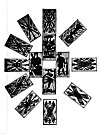
Click to enlarge
Formation of the Tarot--Study of a Colour--The Four Figures--The Ten Numbers--Affinity between the Figures and the Numbers--Study of the Four Colours--General Study of the Minor Arcana.
THE KEY TO THE MINOR ARCANA.
THE Tarot is composed of 78 cards, divided as follows--
56 cards called the minor arcana.
22 cards called the major arcana.
The 56 minor arcana are formed of 4 series of 14 cards each.
The 22 major arcana are formed of 21 numbered cards, and of one un-numbered.
In order to study the Tarot with success, we must then arrange the following packets--
|
4 packets of 14 cards each. |
|
|
|
14 + 14 + 14 + 14 |
= |
56 |
|
1 packet of 21 cards |
= |
21 |
|
1 packet of 1 card |
= |
1 |
|
Total . . . . . . . . |
|
78 |
We shall presently return to the origin of this marvellous conception of the human mind, but for the present we must confine ourselves to the dissection of the machine, and to displaying its mysterious arrangement.
Starting from a fixed and immovable principle, the constitution of the sacred tetragrammaton, Yod-he-vau-he, the Tarot develops the most divers combinations, without one departure from its basis. We shall now unveil this wonderful construction, which confirms in its application the universal law of analogies.
The explanations which follow may appear dry to some persons; but they must remember that we are now giving them an almost infallible key to the ancient or occult science; and they will understand that they must open the door of the sacred arch for themselves.
STUDY OF A COLOUR.
Let us now take one of the packets of fourteen cards and analyze its construction.
This packet, taken as a whole, corresponds to one of the colours of our pack of cards. The 4 packets respectively represent the wands or sceptres, corresponding to our clubs; the cups or goblets, corresponding to our hearts; the swords, corresponding to our spades; and money or Pentacles, corresponding to our diamonds.
We shall now study one of these packets, for instance that of Sceptres.
The packet consists of 4 figures: the king, queen, knight, and knave, and of ten cards which simply bear numbers.
The ace, two, three, four, five, six, seven, eight, nine, and ten.
THE FOUR FIGURES.
We must first consider the four figures--
The king represents the active, the man, or male.
The queen represents the passive, the woman, or female.
The knight represents the neuter, the adolescent.
Lastly, the knave represents the 4th term of this sequence, which may be figured in this way--
|
|
King |
|
|
Queen |
Knave |
|
|
|
Knight |
|
This sequence is only an application of the general law Yod-he-vau-he, which we already know, and the analogy is easily established--
|
|
King |
|
|
Queen |
Knave |
|
|
|
Knight |
|
The knave therefore corresponds with the second He, i. e. it is only a term of transition; but transition between what?
Between the four figures and the ten numbers following.
THE TEN NUMBERS.
Let us now study these numbers. We are acquainted with the Law of numbers, or law of the sequences, which we have already stated in these terms--
1 -- 2. 3
4 -- 5. 6
7 -- etc.
The ten cards cannot escape from this law, and we can at once arrange them in series.
The first series will be formed of the ace, or 1, representing the active, of the 2 personating the passive, of the 3 for the neuter, and lastly of the 4, which represents the transition from one series to another.
1, 2, 3, 4 therefore correspond also with the Yod-he-vau-he, and are thins formulated--
|
|
Ace |
|
|
Two or 1st He |
2nd He Four |
|
|
|
Vau |
|
The other series follow the same rule exactly, the second He of the preceding series becoming the Yod of the following, series: thus 4, the fourth term of the first series, becomes the first term of the second series; 7, the fourth term of the second, becomes the first term of the third, as follows--
We see that the same law, Yod-he-vau-he, can be applied to these series. Since this law is also applicable to the four figures, we can make a comparison based on the following proposition--
Two terms (the numbers and the figures) equal to a same third (the law Yod-he-vau-he) are equal between themselves.
THE SEQUENCE IN ONE COLOR
|
|
|
|
|
King |
|
|
|
|
|
|
|
|
Queen |
Knave |
|
|
|
|
|
|
|
|
|
Knight |
|
|
|
|
|
|
1 |
|
|
4 |
|
|
7 |
|
|
2 |
4 |
5 |
7 |
8 |
10 |
|||
|
|
3 |
|
|
6 |
|
|
9 |
|
If we now group all the numbers of the sequence according to the letter of the tetragrammaton, to which they are analogous, we shall find--
|
Representing Yod |
1--4--7 |
|
Representing the 1st He |
2--5--8 |
|
Representing the Vau |
3--6--9 |
|
Representing the 2nd He |
10 |
|
|
(1. 4. 7) |
|
|
(2. 5. 8) 1st He |
2nd He (10) |
|
|
|
Vau |
|
The figure 10 therefore acts for the numbers, as the knave acts for the figures, that is to say, it serves as a transition. Between what?
Between one colour and another.
AFFINITY BETWEEN THE FIGURES AND THE NUMBERS.
We have already studied both the figures and the numbers separately, let us now see what connection exists between the figures and the numbers.
If we group the similar terms according to the identical Law which rules them, we shall find them as follows--
|
The King is the |
Yod |
of |
1. 4. 7 |
|
The Queen --- |
He |
of |
2. 5. 8 |
|
The Knight --- |
Vau |
of |
3. 6. 9 |
|
The Knave--- |
2nd He |
of |
10 |
The sequence of the figures is reproduced three times in the series of numbers, that is to say, that each series of numbers represents a conception of the figures in each of the three Kabbalistic worlds.
The series 1, 2, 3, 4 represents the emanation of the sequence king, queen, knight, knave in the divine world.
The series 4, 5, 6, 7 represents this evolution in the human world.
The series 7, 8, 9, 10 represents this evolution in the material world.
Each colour is a complete whole, formed after the manner of beings.
Of a material body:
(Knight---7.8.9)
Of a vital force:
(Queen---4.5.6)
Of an intellect:
(King---1.2.3)
Of reproductive organs:
(Knave---10)
Each of these parts can subdivide itself into three others, as the numbers indicate. 1
Ut us, however, return to our deduction, and by summing up the results obtained, we shall find--
Representations of the Yod:
The King
The 1 or Ace
The 4
The 7
Representations of the He:
The Queen
The 2
The 5
The 8
Representations of the Vau:
The Knight
The 3
The 6
The 9
Representations of the 2nd He:
The Knave
The 10
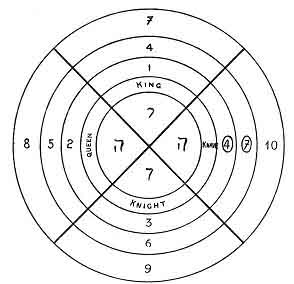
FIGURATION OF ONE COLOR
Head--Spirituality
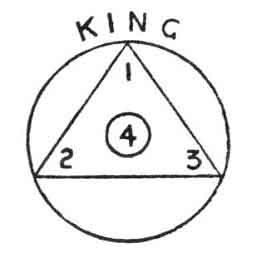 Divine World
Divine World
Body--Materiality
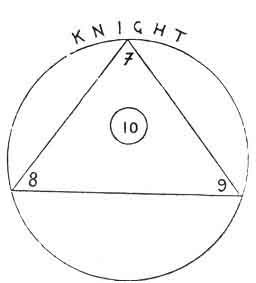 Material World
Material World
Transition from one being to another
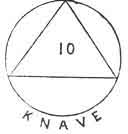 Transition from another one world to
Transition from another one world to
STUDY OF THE FOUR COLOURS.
Supplied with these data, let us continue our study, and apply the same principle to the other cards.
The laws which we have defined for the constitution of one colour, apply in the same way to the other three colours.
But when we consider the four colours of the Tarot, new deductions will be called forth. We must remember that these four colours are: the Sceptre, the Cup, the Sword, and the Money or Pentacles.
The Sceptre represents the Male or the Active.
The Cup is the image of the Passive or Feminine.
The Sword represents the union of the two by its crucial form.
Lastly, the Pentacles represent the second He.
The authors who have philosophically studied the Tarot are all unanimous in asserting the analogy that exists between the tetragrammaton and the four colours. Guillaume Postel, 1 and above all Eliphas Levi, 2 have developed these studies with great results, and they show us the four letters of the tetragrammaton applied in the symbolism of every cultus.
We must pause one moment to notice the analogy, between these letters and the symbols of the Christian religion.
The Yod or Sceptre of the Tarot is represented by the episcopal crosier.
The 1st He or Cup is represented by the Chalice.
The Vau or Sword by the Cross, bearing the same form.
The 2nd He or Pentacles by the Host, the transition from the natural to the Supernatural world.
The series which we have studied in one colour is defined equally strictly in the four colours regarded as a whole, thus--
|
|
Sceptre |
|
|
Cup or He |
2nd He or Money |
|
|
|
Vau |
|
A COMPREHENSIVE GLANCE OVER TIRE MINOR ARCANA.
If we look back a little, we can easily judge the road we have traversed.
The four colours considered in globo have shown us the application of the law Yod-he-vau-he.
But the same law is reproduced in each of the colours taken separately.
The four figures represent Yod-he-vau-he;
The four series of numbers also.
Let us then arrange all the cards according to their affinities, and we shall obtain the following results--
|
The 4 Kings |
= Yod |
|
The 4 Aces |
|
|
The 4 Fours |
|
|
The 4 Sevens |
|
|
The 4 Queens |
=He |
|
The 4 Twos |
|
|
The 4 Fives |
|
|
The 4 Eights |
|
|
p. 46 The 4 Cavaliers |
=Vau |
|
The 4 Threes |
|
|
The 4 Sixes |
|
|
The 4 Nines |
|
|
The 4 Knaves |
= He |
|
The 4 Tens |
If we wished to represent this arrangement by a synthetic diagram, we should place the sacred name in the centre of a circle divided into four parts, which respectively correspond with each of the letters Yod-he-vau-he. In each of the quarters, the cards that are analogous to the letters of the tetragrammaton will radiate from the centre. See the diagram on page opposite.
The figures have the same connection with the colours as the numbers have with the figures.
The sequence of the figures is reproduced in the three worlds by the numbers; the same thing takes place in the sequence of colours: Sceptre, Cup, Sword, Pentacles are reproduced in the figures.
The Sceptre is the Yod of the 4 Kings.
The Cup is the He of the 4 Queens.
The Sword is the Vau of the 4 Knights.
The Pentacles is the He of the 4 Knaves.
And just as each colour has a complete whole, formed of a body, of a soul, and of a mind or vital force, so the four colours form a complete whole thus composed:--
The material body of the minor arcana:
The 4 Knights
The 4 Sevens
The 4 Eights
The 4 Nines
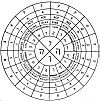
Click to enlarge
GENERAL FIGURE OF THE MINOR ARCANA.--Disposition of Series.
The vital body of the minor arcana:
The 4 Queens
The 4 Fours
The 4 Fives
The 4 Sixes
The intellectual body:
The 4 Kings
The 4 Aces
The 4 Twos
The 4 Threes
Reproductive organs:
The 4 Knaves
The 4 Tens
We can only point out the very instructive affinities shown in these figures; they can be carried to a great length.
We give these indications in order to demonstrate the management of analogy, the method of the occult science, to which we have so frequently alluded in our preceding works.
We need only compare this last diagram, which represents the four colours, with the first, which depicted one only, to see at once that the law upon which these two diagrams are constructed is the same, only that the applications of it are varied.
It is the same law by which the cells that form the human being group themselves to constitute organs, the organs group themselves to form members, and the grouping of the latter produces the individual. 1
We have drawn the following conclusion from all that we have already stated--
The Pentacles, responding to the second He, indicates a transition.
Between what?
Between the minor and major arcana.
41:1 We wished to make this application of the Tarot in order to show Initiates what results might be expected from the laws explained by studying it.
44:1 Clavis abscunditarum reram.
44:2 Eliphas Levi, Dogme et Rituel de la Haute Magie.
49:1 See the Traité Élémentaire de Science Occulte, chap. iii.